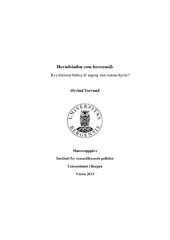| dc.contributor.author | Torvund, Øyvind | eng |
| dc.date.accessioned | 2013-09-02T12:11:44Z | |
| dc.date.available | 2013-09-02T12:11:44Z | |
| dc.date.issued | 2013-06-03 | eng |
| dc.date.submitted | 2013-06-03 | eng |
| dc.identifier.uri | https://hdl.handle.net/1956/7020 | |
| dc.description.abstract | Problemstillinga i denne oppgåva er: I kva grad har terrorangrepa i perioden 1998-2011 vore retta mot ein stats hovudstad, og kva variablar forklarer hovudstadsangrep? Hovudhypotesen i oppgåva er at fleirtalet av angrepa er retta mot hovudstaden på grunn av at dei har ei rekkje funksjonar som gjer dei attraktive for terroristar. Ein tredjedel av statane i verda har opplevd fleirtalet av terrorangrepa i hovudstaden. Hovudstaden er spesielt utsett for angrep i statar som opplever lite terrorisme, og det er også ein del regionale skilnader. Statistikk viser også at angrep i hovudstadar i gjennomsnitt har vore meir dødelege enn aksjonar andre stader i perioden. Hovudhypotesen blir likevel avvist sidan berre 16,5 prosent av alle angrep har skjedd i hovudstadar. Prosentdelen terrorangrep i hovudstader har også gått noko ned i løpet av perioden. Ein regresjonsanalyse viser at sentralstatar er meir utsette for hovudstadsangrep enn føderalstatar. Ideologi er også ein viktig faktor for å forstå kvar terroristar slår til. Islamistiske har større sannsynlegheit for å slå til mot hovudstadar, medan nasjonalistar i større grad slår til mot mål utanfor hovudstaden. I statar som er involvert i væpna konfliktar skjer ein mindre del av terrorangrepa i hovudstaden. Det er også undersøkt om regimestatus og økonomiske forhold som GDP-nivå, HDI-nivå og bruken av pengar på velferd kan forklare hovudstadsangrep. Det er likevel ingen tydeleg effekt for desse variablane. | en_US |
| dc.description.abstract | The research question in this thesis is: To what extent has the terrorist attacks from 1998 to 2011 been directed against capital cities, and what kind of variables explain capital city attacks? The main hypothesis is that most terrorist attacks are directed against the capital city due to the fact that they have a number of functions that makes them attractive for terrorists. A third of the states in the world have experienced most of the attacks against targets in the capital city. The capital is particularly vulnerable in states which generally experience little terrorism, and there are some regional differences. Statistics also shows that attacks in the capital cities on average have been more deadly than attacks elsewhere in the period. Nevertheless, the main hypothesis is falsified since only 16.5 per cent of the attacks have happened in capital cities. The percentage of terrorist attacks directed against capital cities has decreased during the period. A regression analysis suggests that unitary states are more prone to capital attacks than federal states. Ideology is also a key factor for understanding terrorist's choice of places to attack. Islamists are more likely to attack targets in the capital city, whereas nationalists to a greater extent attack targets outside the capital city. In states with armed conflict a smaller share of the attacks are directed against the capital city. It is also examined whether regime status and economic conditions like GDP level, HDI level and welfare spending can explain capital city attacks, but no clear effect is evident. | en_US |
| dc.format.extent | 1003171 bytes | eng |
| dc.format.mimetype | application/pdf | eng |
| dc.language.iso | nno | eng |
| dc.publisher | The University of Bergen | eng |
| dc.subject | terrorisme | eng |
| dc.subject | terrorisme | eng |
| dc.title | Hovudstaden som terrormål: Kva faktorar bidreg til angrep mot statens hjerte? | eng |
| dc.type | Master thesis | en_US |
| dc.rights.holder | Copyright the author. All rights reserved | en_US |
| dc.description.degree | Master i Sammenliknende politikk | |
| dc.description.localcode | SAMPOL350 | |
| dc.description.localcode | MASV-SAPO | |
| dc.subject.nus | 731114 | eng |
| fs.subjectcode | SAMPOL350 | |
